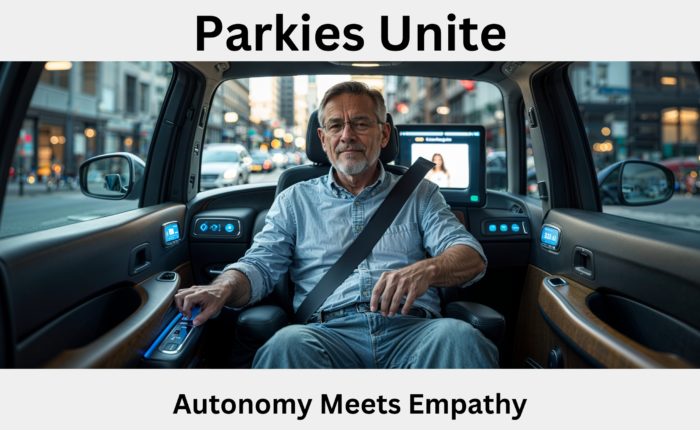Can Autonomous Shared Rides Deliver?

Inclusive Tech for Parkinson’s: Can Autonomous Shared Rides Deliver?
As autonomous vehicles edge closer to mainstream adoption, one critical question remains unanswered: will they work for everyone—especially for people with Parkinson’s disease (PwPD)? A recent study explored this exact question, revealing important insights that could shape how self-driving shared rides (ASRs) are designed, operated, and made accessible to people living with Parkinson’s.
This study represents a forward-thinking intersection of mobility innovation and inclusive design. By speaking directly to PwPD and walking them through the various steps of an ASR trip, researchers uncovered not just general preferences—but deep, specific user needs, challenges, and hopes for the future of autonomous mobility.
Let’s walk through the research findings step-by-step.
Step 1: Why This Study Was Needed
Parkinson’s disease affects not only movement but also cognition, balance, and sensory processing. That means PwPD often experience barriers in traditional transit—things like delayed boarding, difficulty following instructions, or trouble navigating changes in route. ASR technology could potentially reduce some of these obstacles, but only if it’s designed with these unique challenges in mind.
To evaluate that, researchers conducted in-person interviews with 20 people with Parkinson’s disease. These interviews aimed to identify:
- Daily travel habits and hurdles for PwPD
- Reactions to automated ride experiences
- Concerns around safety, technology, and autonomy
- Real-world needs for accessible, human-aware design
Participants were shown short animated video clips depicting five core trip segments (based on U.S. Department of Transportation standards):
- Booking
- Identification
- Onboarding
- Traveling
- Exiting
Each participant was then asked to provide feedback—qualitative (opinions and experiences) and quantitative (rankings and ratings).
Step 2: The Top Concerns for Parkinson’s Travelers
Using a Friedman test (a statistical tool for comparing ranked items), the study identified significant differences in how PwPD perceived various barriers.
Three key concerns emerged again and again:
1. Safety
PwPD felt uneasy about trusting a vehicle without a human driver. Many expressed fears about emergency handling, unexpected stops, or even simple mechanical errors. Questions like “What if I freeze and can’t move?” or “Who helps if I fall while exiting?” were voiced with genuine anxiety.
2. Lack of Customer Service or Human Help
The absence of real-time, human customer support was another red flag. People wanted more than a chatbot—they wanted the option to connect to a live agent for reassurance, guidance, or in-the-moment help.
3. Technology Design and Usability
Touchscreens, voice commands, and fast-moving interfaces were seen as potential obstacles. PwPD often experience tremors, slowness of movement (bradykinesia), or reduced cognitive flexibility, making standard tech interfaces difficult to use. They called for simplified tech, clear prompts, and visual/audio redundancy.
Step 3: A Deeper Dive into the Trip Segments
Participants rated each of the five trip stages based on difficulty and anxiety. Here’s what came up:
🟡 Booking – Most Anxiety-Provoking
This stage involves selecting preferences, scheduling, and confirming the ride. For many PwPD, booking was the hardest part, triggering uncertainty about accessibility settings, pricing, and lack of human backup if a mistake was made.
🔵 Identification
While slightly easier than booking, this step raised concerns about facial recognition technology failing due to tremors or changes in appearance caused by PD symptoms.
🟢 Onboarding
Getting into the vehicle brought up physical accessibility issues—such as seat height, door width, and balance support—that many systems haven’t yet accounted for.
🟠 Traveling
This stage was smoother, though riders still worried about emergency protocols, route updates, and the inability to communicate changes on the go.
🔴 Exiting
Exiting posed fall risks and confusion—especially if automated voices or exit instructions were unclear or rushed. Participants also emphasized the need for seatbelt assistance.
Step 4: Solutions to Consider
The interviews yielded actionable recommendations for ASR developers, transit agencies, and technology partners:
- Built-in live customer service access (video or audio)
- Flexible interfaces with adjustable font sizes, tactile buttons, and clear voice guidance
- Assistive devices for entry, exit, and seatbelt use
- Emergency protocols tailored to PwPD (visible, reachable panic buttons and easy access to 911 or a support line)
- Mobility-friendly design: lower step-ins, grab bars, wider doors
- Psychological comfort: assurances that someone is monitoring or “on call”
- Customization: allow users to preset ride preferences based on diagnosis
Step 5: Moving Toward Inclusive Mobility
This study sends a powerful message to the ASR industry: autonomy should not come at the cost of accessibility. By incorporating direct feedback from people with Parkinson’s disease, we can design ASR systems that truly support independence, safety, and dignity.
As we build the future of shared mobility, let’s make sure PwPD—and all communities with unique mobility challenges—are not only included but prioritized.
Image Prompt:
Create a photo-realistic image of a middle-aged man with Parkinson’s disease sitting inside an autonomous shared ride vehicle. The interior should feature warm lighting, an ergonomic seat with an extended safety belt, a touchscreen with large buttons, and a screen displaying a smiling virtual assistant. The man is calmly reaching for the seatbelt while the outside city scene reflects through wide, accessible doors. The atmosphere should feel safe, supportive, and inclusive, with technology clearly assisting the passenger.
Three 20-character taglines:
- Autonomy Meets Empathy
- Mobility with Dignity
- Designed for Everyone
Negative prompt:
Malformed limbs, extra limbs, mutated hands, disfigured face, bad anatomy, malformed hands, Text, lettering, captions, generating images with text overlays
SEO keywords:
autonomous shared rides, Parkinson’s accessibility, self-driving car usability, inclusive mobility solutions, assistive ride technology
Closing:
AI-generated medical infographics on Parkinson’s symptoms, treatment advances, and research findings; I hope you found this blog post informative and interesting. www.parkiesunite.com by Parkie.